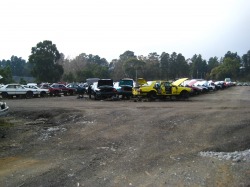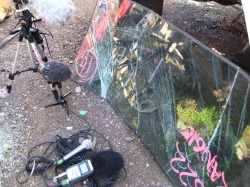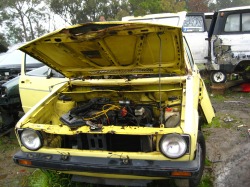|
Location Kilsyth Melbourne Equipment Zoom H4N D112 & Beta 58A and Zoom H4 MKh60 Tripod mount This is the first big recording session I have done for a while. Full time work and all the documentation for Sound Library has kept me away from major recording trips for a while, but I do have some good sessions planned over the next few weeks so things should pick up again. Today I went to a car wreckers in Melbourne’s eastern suburbs, just at the foot of the Dandenongs mountain range. The guys at Pick a Part were really helpful and let me wander around and record some busted old cars. The set-up down there is perfect for what I do as all the cars are neatly laid out to allow people to go in and find the car they need and remove the parts they want, so its all very organised. This allowed me to go through and find the specific things I was after. I wanted cars that were already heavily damaged, so if I bashed on any of the panels I would not be damaging anything useful to the wreckers, but also because already damaged panels rattle and squeak better than new panels. I spent three hours moving around the yard sampling various sounds. With the new equipment it is easier for me to record with a range of mics and I am finding this is giving me far more options with the material I end up with. I need to sort things out a little to make it easier to work this, but using the H4N with both two mic inputs and its own internal microphones working is proving to be really effective. I attach my AKG D112 to one channel to capture any high power sounds as well as good low end material, and to the second input I attach the Shure beta 58A which is a straight forward good workhorse mic. The differences in sound colour from the two mics are noticeable on most recordings. I have also found the H4N’s own mics are actually pretty good. I need to be careful to protect them from wind noise, but once that’s taken care of they have been giving me some good sample material. Lastly I have the older H4 running my MKH60 shotgun mic. Its my old reliable mic, but I have found that often one of the other mics gives me a sample that I would prefer to use. With the range of samples I captured from today I am going to experiment with making mix blends of the different mic samples to create a new version of the sound that uses the best elements of each of the mic versions. By mixing them together I can hopefully capture the fuller low end frequencies of the D112 with some of the crisper high end material from the MKH60 and 58A. It will be different every time I record, but having a general understanding of each mics strengths should help me to create better mixes for any situation. The D112 was great for loud crashes and bangs, but struggled a little with something more subtle like bouncing a tyre up and down on the road. This makes it a good complement for the MKH60 as it sometimes struggles with the higher level sounds and can max out if its placed too close to the source. The other advantage of having small portable units like the H4 series is it was very easy for me to place the unit and mics inside areas like car boots, or between panels and then beat on the outside of the panels to capture the sound. This way I can have a microphone outside and inside simultaneously to provide more options of raw material. I may right up a small section on how I go with creating mix blends of some of the material from today’s recording session. I will still archive the multiple mic samples so I have them all, but I don’t think I will include all of these in the library. I think having several versions of each sound to cover various types of microphone and its position is being a little excessive, even for this library.
Website www.pick-a-part.com.au/
0 Comments
Leave a Reply. |
AuthorStephan Schütze has been recording sounds for over twenty years. This journal logs his thoughts and experiences Categories
All
Archives
April 2019
|



 RSS Feed
RSS Feed
